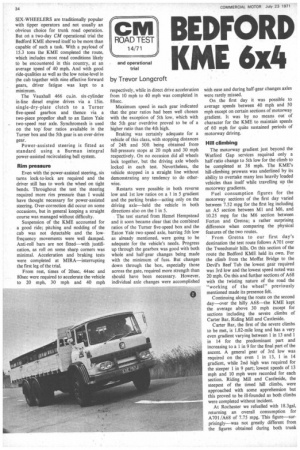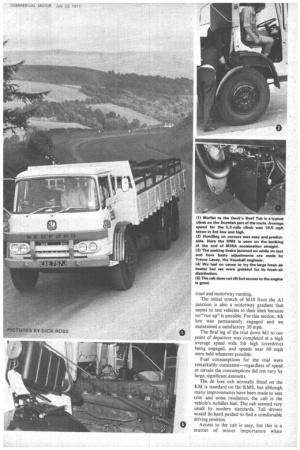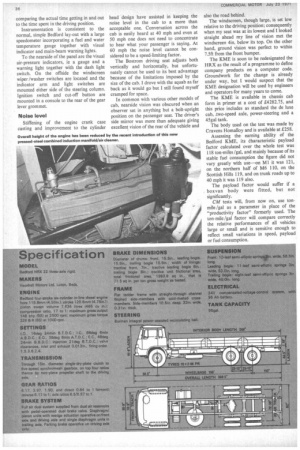BEDFORD KME 6x4
Page 36

Page 37

Page 38

If you've noticed an error in this article please click here to report it so we can fix it.
by Trevor Longcroft SIX-WHEELERS are traditionally popular with tipper operators and not usually an obvious choice for trunk road operation. But on a two-day CM operational trial the Bedford KME showed itself to be more than capable of such a task. With a payload of 15.3 tons the KME completed the route, which includes most road conditions likely to be encountered in this country, at an average speed of 40 mph. And with good ride-qualities as well as the low noise-level in the cab together with nine effective forward gears, driver fatigue was kept to a minimum.
The Vauxhall 466 cu.in. six-cylinder in-line diesel engine drives via a 15in. single-dry-plate clutch to a Turner five-speed gearbox and thence via a two-piece propellor shaft to an Eaton Yale two-speed rear axle. Synchromesh is used on the top four ratios available in the Turner box and the 5th gear is an over-drive gear.
Power-assisted steering is fitted as standard using a Burman integral power-assisted recirculating ball system.
Rim pressure
Even with the power-assisted steering, six turns lock-to-lock are required and the driver still has to work the wheel on tight bends. Throughout the test the steering required more rim pressure than I would have thought necessary for power-assisted steering. Over-correction did occur on some occasions, but in general keeping a straight course was managed without difficulty.
Suspension of the KME accounted for a good ride; pitching and nodding of the cab was not detectable and the lowfrequency movements were well damped. Anti-roll bars are not fitted—with justification, as roll on some sharp corners was minimal. Acceleration and braking tests were completed at MIRA—interrupting the first leg of the trial.
From rest, times of 20sec, 44sec and 80sec were required to accelerate the vehicle to 20 mph, 30 mph and 40 mph respectively, while in direct drive acceleration from 10 mph to 40 mph was completed in 88sec.
Maximum speed in each gear indicated that the gear ratios had been well chosen with the exception of 5th low, which with the 5th gear overdrive proved to be of a higher ratio than the 4th high.
Braking was certainly adequate for a vehicle of this class, with stopping distances of 24ft and 50ft being obtained from full-pressure stops at 20 mph and 30 mph respectively. On no occasion did all wheels lock together, but the driving axle wheels locked in each test. Nevertheless, the vehicle stopped in a straight line without demonstrating any tendency to do otherwise.
Restarts were possible in both reverse low and 1st low ratios on a 1 in 5 gradient and the parking brake—acting only on the driving axle—held the vehicle in both directions also on the 1 in 5.
The test started from Hemel Hempstead and it soon became clear that the combined ratios of the Turner five-speed box and the Eaton Yale two-speed axle, barring 5th low as already mentioned, were going to be adequate for the vehicle's needs. Progress up through the gearbox was good with both whole and half-gear changes being made with the minimum of fuss. But changes down through the box, especially those across the gate, required more strength than should have been necessary. However, individual axle changes were accomplished with ease and during half-gear changes axles were rarely missed.
On the first day it was possible to average speeds between 40 mph and 50 mph except on certain sections of motorway gradient. It was by no means out of character for the KME to maintain speeds of 60 mph for quite sustained periods of motorway driving.
Hill climbing
The motorway gradient just beyond the Watford Gap services required only a half-ratio change to 5th low for the climb to be completed at 38 mph. The KME's hill-climbing prowess was underlined by its ability to overtake many less heavily loaded vehicles than itself while travelling up the motorway gradients.
Fuel consumption figures for the motorway sections of the first day varied between 7.52 mpg for the first leg including an A5 section between MI and M6, and 10.25 mpg for the M6 section between Forton and Gretna; a rather surprising difference when comparing the physical features of the two routes.
From Gretna to our first day's destination the test route follows A701 over the Tweedsmuir hills. On this section of the route the Bedford KME held its own. For the climb from the Moffat Bridge to the Devil's Beef Tub the lowest gear required was 3rd low and the lowest speed noted was 20 mph. On this and further sections Of A68 with the twisting nature of the road the "working of the wheel" previously mentioned made its presence felt.
Continuing along the route on the second day—over the hilly A68—the KME kept the average above 30 mph except for sections including the severe climbs of Carter Bar, Riding Mill and Castleside.
Carter Bar, the first of the severe climbs to be met, is 1.82-mile long and has a very even gradient varying between 1 in 13 and 1 in 14 for the predominant part and increasing to a 1 in 9 for the final part of the ascent. A general gear of 3rd low was required on the even I in 13, 1 in 14 gradient, while 2nd high was required for the steeper 1 in 9 part; lowest speeds of 13 mph and 10 mph were recorded for each section. Riding Mill and Castleside, the steepest of the timed hill climbs, were approached with some apprehension but this proved to be ill-founded as both climbs were completed without incident.
At Rochester we refuelled with 18.3gal, returning an overall consumption for A701 /A68 of 7,75 mpg. This figure—surprisingly—was not greatly different from the figures obtained during both trunk road and motorway running.
The initial stretch of MI8 from the Al junction is also a motorway gradient that seems to test vehicles to their limit because no "run-up" is possible. For this section, 4th low was permanently engaged and we maintained a satisfactory 30 mph.
The final leg of the trial down MI to our point of departure was completed at a high average speed with 5th high (overdrive) being engaged, and speeds near 60 mph were held whenever possible.
Fuel consumptions for the trial were remarkably consistent—regardless of speed or terrain the consumptions did not vary by large, significant amounts.
The de luxe cab normally fitted on the KM is standard on the KME, but although many improvements have been made to seat trim and noise insulation, the cab is the vehicle's Achilles heel. The cab seemed very small by modern standards. Tall drivers would be hard pushed to find a comfortable driving position.
Access to the cab is easy, but this is a matter of minor importance when comparing the actual time getting in and out to the time spent in the driving position.
Instrumentation is consistent to the normal, simple Bedford lay-out with a large speedometer incorporating a fuel and water temperature gauge together with visual indicator and main-beam warning lights.
To the nearside of the panel are the visual air-pressure indicators, ie a gauge and a warning light together with the dash light switch. On the offside the windscreen wiper/washer switches are located and the indicator arm and light switches are mounted either side of the steering column. Ignition switch and cut-off button are mounted in a console to the rear of the gear lever grommet.
Noise level Stiffening of the engine crank case casting and improvement to the cylinder head design have assisted in keeping the noise level in the cab to a more than acceptable one. Conversation across the cab is easily heard at 40 mph and even at 50 mph one does not need to concentrate to hear what your passenger is saying. At 60 mph the noise level cannot be considered to be a speed-limiting factor.
The Bostrom driving seat adjusts both vertically and horizontally, but unfortunately cannot be used to its best advantage because of the limitations imposed by the size of the cab. I drove with the squab as far back as it would go but I still found myself cramped for space.
In common with various other models of cab, nearside vision was obscured when an observer sat in anything but a bolt-upright position on the passenger seat. The driver's side mirror was more than adequate giving excellent vision of the rear of the vehicle and also the road behind.
The windscreen, though large, is set low relative to the driving position: consequently when my seat was at its lowest and I looked straight ahead my line of vision met the windscreen 4in. below its top. On the other hand, ground vision was perfect to within 7.5ft from the front bumper.
The KME is soon to be redesignated the HRX as the result of a programme to define company products on a computer code. Groundwork for the change is already under way, but I would suspect that the KME designation will be used by engineers and operators for many years to come.
The KME is available in chassis cab form in primer at a cost of £4282.75, and this price includes as standard the de luxe cab, .two-speed axle, power-steering and a 45ga1 tank.
The body used on the test was made by Cravens Homalloy and is available at £258.
Assessing the earning ability of the Bedford KME, its naracteristic payload factor calculated over the whole test was 118 ton-mites/gal, and mainly because of its stable fuel consumption the figure did not vary greatly with use—on MI it was 121, on the northern half of M6 110, on the Scottish Hills 119, and on trunk roads up to 40 mph it was 119 also.
The payload factor would suffer if a box van body were fitted, but not significantly.
CM tests will, from now on, use tonmile/gal as a parameter in place of the "productivity factor" formerly used. The ton-mile/gal factor will compare correctly the relative performances of all vehicles large or small and is sensitive enough to reflect small variations in speed, payload or fuel consumption.




























































































